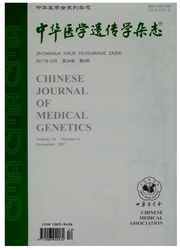

 中文摘要:
中文摘要:
目的分析常染色体显性遗传并多指(synpolydactyly,SPD)一家系的致病基因,为家系成员提供遗传咨询和产前诊断。方法临床诊断依据患者的临床特征和手足X线检查结果;致病基因分析采用候选基因分离策略,通过连锁分析确定该家系致病基因与已知SPD致病基因的连锁关系,PCR扩增HOXDl3基因检测基因突变。于孕16~21周对家系中高危妊娠的胎儿行超声诊断,并抽取孕妇羊水提取胎儿脱落细胞DNA进行连锁分析和突变检测验证。结果临床特征和家系分析表明该家系符合典型的常染色体显性SPD特征;连锁分析表明位于HOXDl3基因两侧的D2S1238、D2S1245两个短串联重复序列位点与该家系致病基因呈紧密连锁状态。家系患者的HOXDl3基因编码的聚丙氨酸链中丙氨酸残基由正常的15个延伸为24个,HOXDl3基因为该家系的突变基因。超声诊断提示妊娠胎儿正常,连锁分析和突变检测也证实胎儿不携带HOXDl3基因突变。结论HOXDl3基因为该先天性并多指(趾)家系的致病基因;联合使用B超和基因诊断方法可为患者提供准确的产前诊断。
 英文摘要:
英文摘要:
Objective To identify potential mutation responsible for synpolydactyly (SPD) in a large Chinese kindred and to offer genetic counseling and prenatal diagnosis for the members of the family. Methods All family members were examined clinically, and blood samples were obtained for linkage analysis and mutation screening. Ultrasound examinations were conducted at 16-21 weeks. Amniotic fluid sample was obtained by ultrasound-guided amniocentesis at 18 weeks of gestation. Results A large kindred affected with SPD was identified and characterized. With two short tandem repeat(STR) markers (D2S1238 and D2S1245) flanking the HOXD13 gene, the disease was mapped to 2q31. A heterozygous 27 bp expansion within the imperfect GCN triplet-repeat of exon 1, c. 184_210dup, was identified. The mutation resulted in a gain of 9 alanine residues between the 14th and 15th alanine of the normal 15-amino-acid-long polyalanine tract. On ultrasound examination, all fingers and toes of the fetus appeared to be normal. Linkage analysis and mutation detection confirmed that the fetus did not inherit the mutant allele from his affected mother. Conclusion HOXD13 gene mutation was responsible for the SPD phenotype in this family. Accurate prenatal diagnosis of SPD was achieved with combined ultrasound and molecular analysis.
 同期刊论文项目
同期刊论文项目
 同项目期刊论文
同项目期刊论文
 A NOVEL DELETION MUTATION IN GJB1 CAUSES X-LINKED CHARCOT-MARIE-TOOTH DISEASE IN A HAN CHINESE FAMIL
A NOVEL DELETION MUTATION IN GJB1 CAUSES X-LINKED CHARCOT-MARIE-TOOTH DISEASE IN A HAN CHINESE FAMIL 期刊信息
期刊信息
